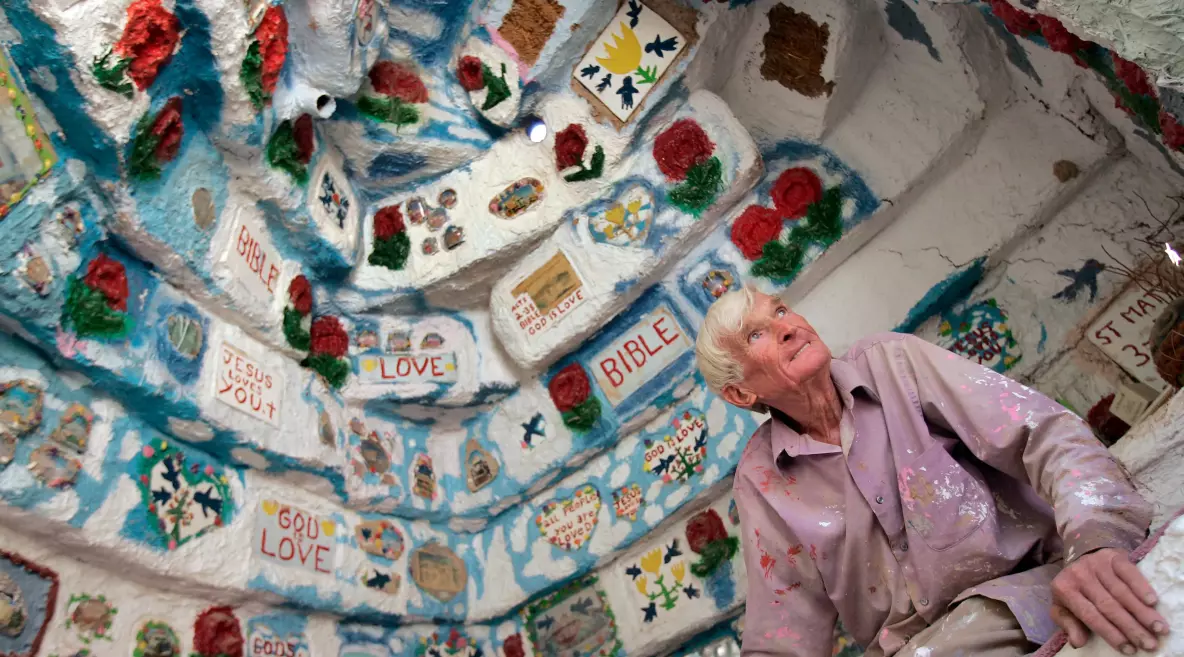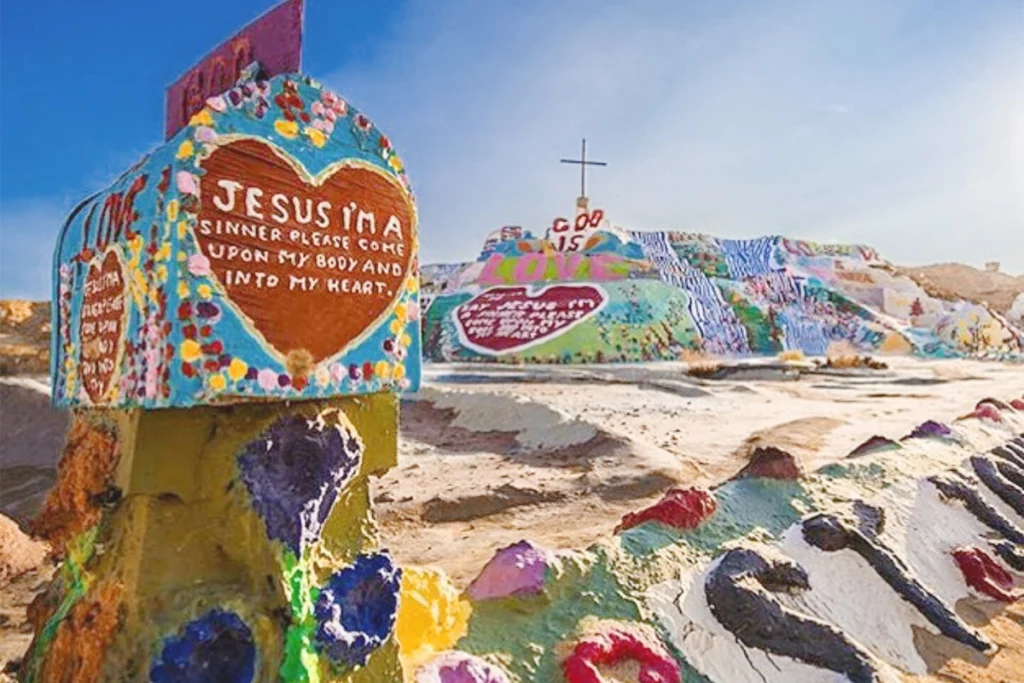About Leonard Knight
“I’m sitting here with a lot of paint, and a lot of adobe, and a lot of happiness, and a lot of love”

Leonard Knight was born on November 1, 1931 near Burlington, Vermont. He has described himself as being a spoiled and rebellious youngest child. He rebelled against having to do chores on the family farm and recalled that there was “too much work not enough play”. His recalcitrance carried over to his frequent absence from school. Knight has explained that he was something of a loner and that his schoolmates often made fun of him for having a stutter.
This combination of lack of interest in school and badgering by other students led to his dropping out in tenth grade, although he has stated that he is not proud of his failure to complete high school. Once Knight dropped out of school he had to learn how to survive on his own. As he has looked back on his childhood, he recalled having dreamed about one day moving to California. He has said that his mountain is his childhood dream coming true.
In 1951, at age 20, Knight was drafted into the Army as the Korean War was winding down. Knight was looking forward to seeing the world as he traveled to Kentucky and then to Fort Knox. After he had completed an extended period of training, he was sent to Korea, but the war ended only ten days after he arrived. He then returned home to Vermont after receiving an Honorable Discharge.
After his discharge from the Army, Knight supported himself by picking up odd jobs, such as painting cars and giving guitar lessons. He ultimately painted cars for over twenty years and taught countless guitar students. Knight believed in starting at the bottom and moving up in order to learn, but he never experienced great career success.

Spiritual Awakening
“Leonard Knight was one of those men who was so singular of vision that from a distance some would brush it off as crazy. But it didn’t take much to realize what Leonard was. Just a conversation and you would know—this man was a saint, an American sadhu in the desert of southern California. The mountain was his living daily meditation.”
Aaron Huey / National Geographic, 2014
When Knight was 36, he remembers suddenly experiencing a spiritual awakening. One day while listening to his sister speak of Jesus, he felt troubled and left his sister’s company. He recalls that as he sat alone in his van his passion for God came on suddenly. He began to recite the Sinner’s Prayer, “Jesus, I’m a sinner, please come upon my body and into my heart.” He states that “For twenty minutes I was just saying it over
and over again, and it changed my life completely to the good.” This moment began his lifelong, unfaltering dedication to Jesus.
Once Knight’s spiritual passion was unleashed, he went from church to church to share his enthusiasm. Unfortunately, his message of “God is Love” was not kindly received. The churches believed that Knight’s
ideas were too simple, even though simplicity was a main part of the message. As he reflected on that period, “I really loved Jesus a lot and I wanted people to know but nobody’d listen to me”.
In 1970, taking matters into his own hands, Knight developed a new idea; decided to spread his message via hot air balloon. He believed this would be the perfect vehicle to allow God’s Love and the Sinner’s Prayer to reach a broad audience. For the next ten years, Knight prayed for a hot air balloon, but his prayers went unanswered. While he was waiting to receive the balloon, Knight headed West on a road trip in 1980.
However, his van broke down in Nebraska. He had planned on staying in Nebraska for a few days, but he ended up staying for five years. Knight remembers those first ten years as being the longest of his life, and he soon realized that if he wanted a balloon he would need to get it himself.
He began buying fabric and sewing the balloon together by hand. His goal was to build the largest hot air balloon in the world; it would bear the words “God is Love” in large red letters for all to see. The project became much more challenging than Knight imagined. The balloon grew to an unmanageable size, wouldn’t properly inflate, and got caught outside in a storm during fall of 1984 staying buried in the snow for the winter.
Knight left Nebraska for Southern California in spring 1985. He traveled to Quartzsite, Arizona first though, where he knew he could get work changing tires on heavy trucks at Bill’s Truck Stop. After about one year stay, he continued on to Bombay Beach, at the Salton Sea, Imperial Valley, California. He stayed there for two weeks and continued to try and launch his balloon but was unsuccessful. Local authorities ask him to move on, so he went a short distance to Slab City just east of the Town of Niland.
There he found a flat area with a ledge along Beal Road. “Laying the balloon up on that ledge should help get the balloon to inflate” he said. There were over two dozen more attempts, but the balloon’s immense size and deterioration from the weather, resulted in the balloon simply breaking into pieces.

Beliefs
Leonard Knight had a message that he wanted to share with the world. His message was Christian but simple and non-denominational: God is love, accept Jesus into your heart, repent your sins, and be saved.
Again, many church leaders believed this message was too simple and that there was much more to understanding God and salvation. Despite this ambivalence to his message, Knight believed his mountain would do the talking for him and spread his message more widely than if he spoke it himself .
Knight has encouraged and invited everyone to take a trip to visit Salvation Mountain. Although many who come to visit are not religious, Knight has expressed hope that his art will touch all of them. “…That thrills me more than anything because maybe these people will say- Jesus, I’m a sinner, please come into my heart – and change”, said Knight about his visitors. Knight has also said that he would rather make something beautiful instead of preaching and hurting someone’s feelings.
Knight has said that he created the mountain because he loves God, loves people, and wants everyone to talk about God’s love. Knight believes that if his message can spread around the whole world, he’d be happy because love is what the world really needs. He has put it this way: “I believe that God is love, and I believe that Jesus is beautiful and pretty, and we should be comfortable talking about God’s love and the prettiness of God”. Knight has expressed a belief that love is the strongest force on earth and can combat the hate that is so prevalent in today’s world.
Knight’s ability to continue to build and preserve Salvation Mountain was compromised by declining health. In 2011, he was unable to continue his mission and was placed in a long-term care facility.
Continued Challenges
Salvation Mountain has faced and continues to face a number of challenges. These include Knight’s declining health, cooptation, and environmental concerns.
Clearly, Knight’s work, as he has envisioned it is unfinished, and, given his stated mission, might never be complete. His declining health has prevented him from continuing both further development of his project and even the ongoing maintenance it requires.
In 2011, Knight was moved into a care facility in response to his deteriorating health, which included congestive heart failure, cataracts, and other health issues. Since his admission into the facility, he has returned to his mountain only a few times. He has not expressed any plans to return to the mountain on a permanent basis, and so Salvation Mountain will no longer receive his vigilant care (Tony Perry, LA Times 2012).
In terms of preservation, Knight has said that he would rather continue to put coats and coats of paint on the mountain rather than add more material to it. This way, he has reasoned, there is a chance the mountain will stay in good condition for longer. As time passes, the harsh desert weather conditions will continue to take a toll on the mountain’s physical appearance.
Since keeping the monument in pristine condition is a full time job, many volunteers will be needed to keep Knight’s dream alive. The mountain is currently being cared for by a non-profit group, Salvation Mountain Inc. Volunteers have also begun working intensively to maintain and protect the mountain since Knight is now disabled. (Lynn Bremmer, 2012, “Leonard Knight: The Man Who Built Salvation Mountain”).
In 2012, a non-profit organization, Salvation Mountain, Inc., was established to try and preserve Salvation Mountain amid continuing challenges of environmental deterioration, management, and land ownership.
Written by David G. Bromley & Stephanie Urlass for WRSP, 2013.
Sources: Bob “Doc” Sims, 2004 & Salvation Mountain: The Art of Leonard Knight, Yust 1998
Visit Salvation Mountain

Plan a visit
Heading to Salvation Mountain? Here is everything you need to know for your visit.
Our Mission
Mission & Organization
Salvation Mountain is run by a dedicated group of volunteers.
Help save Salvation Mountain and Slab City!
Salvation Mountain and the surrounding Slab City are at risk of being demolished to make way for industrial development. We need your help to save the mountain!
Shop Salvation Mountain
-

Where the Heaven Flowers Grow, Photography Book
$300.00 -

Unisex T-Shirt, White
$25.00 – $30.00 This product has multiple variants. The options may be chosen on the product page -

Sticker 2-Pack
$10.00 -

Road Sign Decal
$12.00




